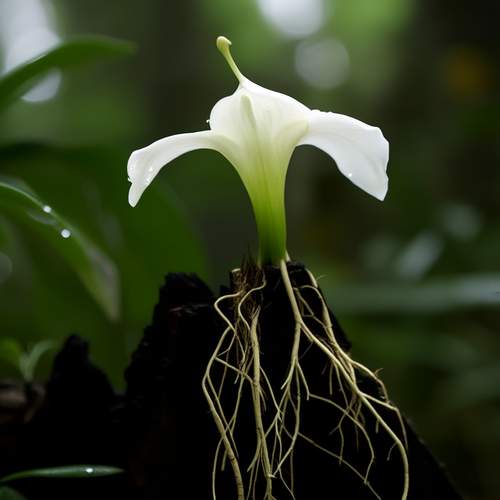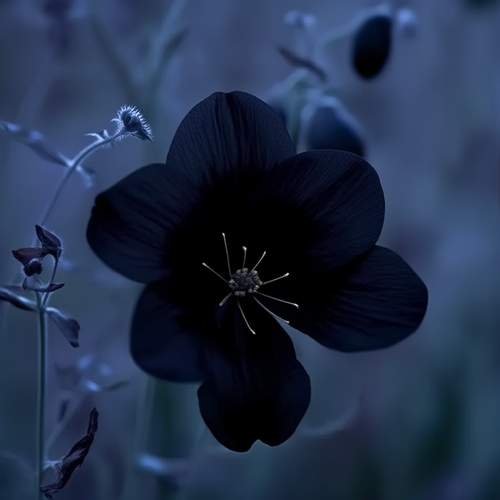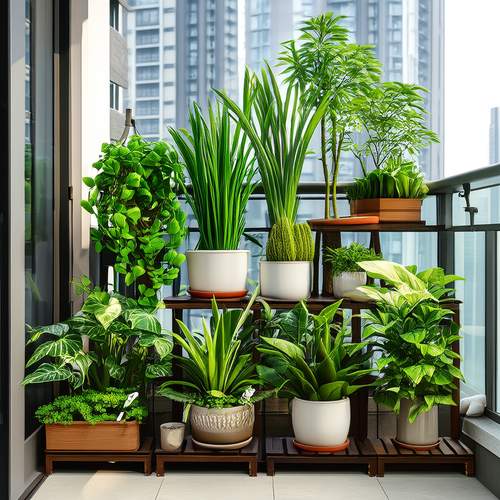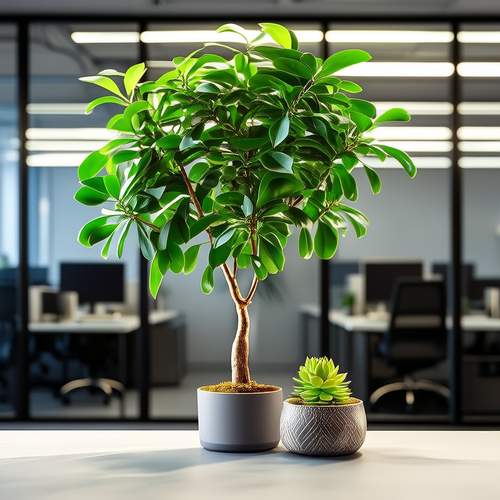In the concrete jungles of modern offices, potted plants have become more than just decorative elements—they’re silent communicators of corporate culture, personal aspirations, and even unspoken office politics. Among the myriad of greenery choices, two extremes stand out: the lush, towering money tree (Pachira aquatica) and the humble, resilient succulent. Each carries its own botanical symbolism, care requirements, and hidden messages that might surprise even the most seasoned plant enthusiasts.
The money tree, with its braided trunk and glossy palmate leaves, has long been considered the botanical equivalent of a golden retriever in office spaces—friendly, low-maintenance, and universally appealing. Its very name suggests prosperity, making it a favorite in financial districts and startup incubators alike. But few realize that this plant’s symbolism runs deeper than simple fortune. In Feng Shui traditions, the five leaves typically found on each stem represent the five elements (wood, water, earth, fire, metal), creating a miniature ecosystem of balance on your desk. The braided trunks? They’re said to "lock in" good luck, though horticulturists will tell you this practice originated simply to keep the fast-growing stems manageable.
Contrast this with the spartan beauty of succulents, those thick-leaved survivors that have taken over modern workspaces like a quiet revolution. Their popularity speaks volumes about contemporary work culture—they thrive on neglect, adapt to harsh conditions, and multiply effortlessly, much like the ideal overworked employee. The jade plant (Crassula ovata), often called the "money plant" (creating some confusing overlap with the money tree), symbolizes growth and renewal. Its plump leaves resemble coins, reinforcing its status as a prosperity charm. Meanwhile, the spiky aloe vera serves as both office first-aid kit and protective talisman, believed to ward off negative energy.
Care requirements for these plants reveal unexpected parallels to workforce management. The money tree, despite its robust appearance, demands consistent attention—too much water and its roots rot, too little and leaves yellow. It’s the corporate high-performer that needs careful nurturing. Succulents, by contrast, flourish through benign neglect, storing resources for lean times. Overwatering kills them faster than drought, a harsh lesson for eager new plant owners who equate care with constant attention. This dichotomy mirrors management styles—some teams thrive under close supervision, others under autonomy.
Seasoned office managers have begun reading these green choices as subtle workplace signals. A money tree at reception suggests traditional values and aspirations for growth. Succulents on every desk might indicate a trendy, design-forward company culture—or possibly tight budgets avoiding expensive foliage. The placement matters too: plants blocking pathways suggest poor space planning, while wilting specimens in client areas silently undermine corporate confidence. Some HR professionals even analyze department-specific plant choices—aggressive sales teams favoring bold tropicals, engineering preferring orderly succulents.
The psychology behind these choices fascinates workplace consultants. Employees often select plants that either complement or compensate for their work environment. A windowless cubicle dweller might choose an impossibly vibrant orchid as defiance against artificial lighting. The overworked assistant nurtures a sprawling pothos vine as tangible proof of something, anything, growing under their care. And when someone gifts a colleague a plant? That’s office politics in leaf form—a peace offering, a passive-aggressive hint about workspace cleanliness ("Here’s something that won’t collect dust"), or territorial marking with roots instead of Post-its.
Modern offices are experimenting with plant symbolism in surprising ways. Tech startups have embraced air plants (Tillandsia) as mascots—no soil needed, just occasional misting, much like their cloud-based business models. Co-working spaces favor towering fiddle-leaf figs as Instagram-ready status symbols. Meanwhile, the recent craze for "plant parenting" has introduced generational dynamics, with younger employees naming their desk succulents while executives view office greenery as strictly decorative. This tension occasionally surfaces in office policies—some companies allocate plant care budgets, others ban personal flora entirely as "distractions" or "fire hazards."
Beyond symbolism, these plants serve practical purposes often overlooked. NASA’s Clean Air Study identified many common office plants as effective air purifiers, with the money tree removing formaldehyde and succulents releasing oxygen at night—ideal for overtime workers. The mere presence of greenery has been shown to reduce stress and increase productivity by 15%, making plant care less about horticulture and more about human resources strategy. Some forward-thinking companies now employ "plant consultants" to optimize greenery placement for both aesthetic and psychological impact.
As workplaces evolve, so does their foliage. The pandemic saw a surge in "resilient plants" that could survive intermittent office occupancy—ZZ plants (Zamioculcas zamiifolia) became favorites for their ability to endure months without water, much like abandoned office snacks gathering dust. Hybrid work models have created split plant personalities—thriving home-office jungles versus carefully rotated "office duty" plants shared among teams. This botanical shuffle has given rise to plant-sharing apps and "plant babysitting" services, creating entirely new economies around office greenery.
Ultimately, whether your workspace features a majestic money tree or a stoic succulent collection, these silent coworkers speak volumes. They reflect corporate values, individual personalities, and the unspoken needs of modern work life—for growth, for resilience, for occasional pruning of unnecessary burdens. The next time you water your desk plant, consider what it might be saying about you, your company, and the delicate ecosystem you’re both trying to cultivate.

By /May 21, 2025

By /May 21, 2025

By /May 21, 2025

By /May 21, 2025

By /May 21, 2025

By /May 21, 2025

By /May 21, 2025

By /May 21, 2025

By /May 21, 2025

By /May 21, 2025

By /May 21, 2025

By /May 21, 2025

By /May 21, 2025

By /May 21, 2025

By /May 21, 2025

By /May 21, 2025

By /May 21, 2025

By /May 21, 2025

By /May 21, 2025

By /May 21, 2025